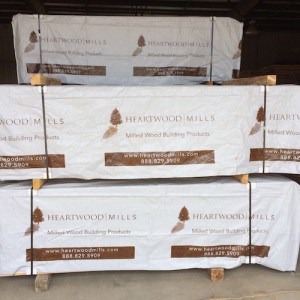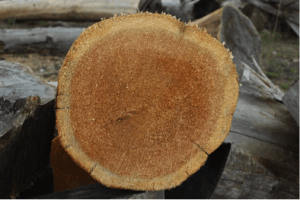The No. 1 Thing to Look for In Log Home Building Materials
 Heartwood Mills’ founder, Bernie Kondrat, learned at a young age the advantage of using a durable wood like Northern White Cedar for building projects. When he was just 8 years old, Bernie helped his grandfather install fences in northern Michigan. The pair used many wood varieties to construct the posts, from Pine and Spruce and Tamarack to Balsam and White Cedar.
Heartwood Mills’ founder, Bernie Kondrat, learned at a young age the advantage of using a durable wood like Northern White Cedar for building projects. When he was just 8 years old, Bernie helped his grandfather install fences in northern Michigan. The pair used many wood varieties to construct the posts, from Pine and Spruce and Tamarack to Balsam and White Cedar.
When he returned to the woods years later, Bernie noticed one thing: The Northern White Cedar posts remained strong and steadfast; posts constructed from the other wood types suffered deterioration and decay. Bernie isn’t the only person to recognize Northern White Cedar’s strength. Many years before, Native Americans used it to craft their canoes, while pioneers constructed bunk homes from it.
What makes Northern White Cedar so much stronger than other wood varieties in the area? Because Northern White Cedar is a slow-growing wood, it contains a larger section of heartwood — a material so important to wood’s strength and durability that we named our business after it.
Anatomy of a Tree

If you cut through any tree, you’ll notice two rings of color. These rings represent layers of growth. The outer rings, which also are lighter, are called sapwood, aptly named because
this is the section of the tree through which water and sap flows. In order to use sapwood for building materials such as log siding, all of this moisture must be removed through
extensive kiln-drying. Even then, this section of the tree is naturally more susceptible to issues such as shrinking, cracking, fungus, decay, and discoloration.
The darker core of the tree is appropriately named the heartwood. Heartwood forms when sapwood dries out and its pores fill with organic matter. Since this section is naturally less moist, it takes less time and effort to kiln-dry to ensure the optimum moisture content for log siding and other building materials. It’s also stronger and has more of a natural resistance to rot and decay.
Different wood species convert sapwood to heartwood at different rates. Fast-growing trees typically are characterized by a wide band of sapwood surrounding a thin inner heartwood ring. Slow-growing trees form heartwood early in life, and have a thin ring of sapwood wrapped around a large heartwood core.
Northern White Cedar: A Wood with Heart(wood)
There are many great varieties of wood for log siding and other log home building materials. When making your selection, ask for products made from the heartwood of the tree.
At Heartwood Mills, we typically recommend Northern White Cedar for log siding, log paneling, decking, stairs, railings, and more. Northern White Cedar is a slow-growing tree with a small diameter, so it contains only a small amount of sapwood — just ¾ of an inch in a 10-inch diameter log. During our milling process, we remove this sapwood and leave only the strong heartwood behind. In fact, Northern White Cedar typically is composed of heartwood in nearly 100 percent of its lumber pieces.
The removal of this sapwood layer saves homeowners years of headaches and maintenance. Over time, homeowners will reap the benefits of a truly superior building product that will last for generations without ongoing and expensive repairs. Their log siding and other wood materials won’t discolor or bleed as easily, limiting the need for restaining. It also will be less susceptible to damage caused by insects and the elements. Recommending and using quality building products like Northern White Cedar will ensure the long-term satisfaction of your customers.
Heartwood Mills is a premier supplier of quality building products, from log siding and log paneling to trusses and trims, milled from the best varieties of wood, including Northern White Cedar. Contact our experts to discuss the best material for your next log home building or remodeling project.
